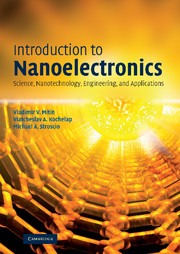Book contents
- Frontmatter
- Contents
- Preface
- List of notation
- 1 Toward the nanoscale
- 2 Particles and waves
- 3 Wave mechanics
- 4 Materials for nanoelectronics
- 5 Growth, fabrication, and measurement techniques for nanostructures
- 6 Electron transport in semiconductors and nanostructures
- 7 Electrons in traditional low-dimensional structures
- 8 Nanostructure devices
- Appendix: tables of units
- Index
8 - Nanostructure devices
Published online by Cambridge University Press: 05 June 2012
- Frontmatter
- Contents
- Preface
- List of notation
- 1 Toward the nanoscale
- 2 Particles and waves
- 3 Wave mechanics
- 4 Materials for nanoelectronics
- 5 Growth, fabrication, and measurement techniques for nanostructures
- 6 Electron transport in semiconductors and nanostructures
- 7 Electrons in traditional low-dimensional structures
- 8 Nanostructure devices
- Appendix: tables of units
- Index
Summary
Introduction
In previous chapters, fundamental physical processes on the nanoscale, analysis of nanomaterials, and nanofabrication methods were all discussed extensively. The knowledge gained in these previous discussions makes it possible to consider and analyze a variety of different nanostructure devices. In this chapter, we consider electronic, optical, and electromechanical devices. Some of these devices mimic well-known microelectronic devices but with small dimensional scales. This approach facilitates applications to devices with shorter response times and higher operational frequencies that operate at lower working currents, dissipate less power, and exhibit other useful properties and enhanced characteristics. Such examples include the field-effect transistors and bipolar transistors considered in Sections 8.3 and 8.5.
On the other hand, new generations of the devices are based on new physical principles, which can not be realized in microscale devices. Among these novel devices are the resonant-tunneling devices analyzed in Section 8.2, the hot-electron (ballistic) transistors of Section 8.5, single-electron-transfer devices (Section 8.4), nanoelectromechanical devices (Section 8.7), and quantum-dot cellular automata (Section 8.8).
As a whole, the ideas presented in this chapter provide an understanding of the future development of nanoelectronic and optoelectronic devices that may be realized through the wide use of nanotechnology.
Resonant-tunneling diodes
Diodes or, in other words, two-terminal electrical devices, are the simplest active elements of electronic circuits. Some applications of diodes are based on their nonlinear current–voltage characteristics. Another important capability required of diodes is their operational speed.
- Type
- Chapter
- Information
- Introduction to NanoelectronicsScience, Nanotechnology, Engineering, and Applications, pp. 242 - 322Publisher: Cambridge University PressPrint publication year: 2007
- 1
- Cited by



